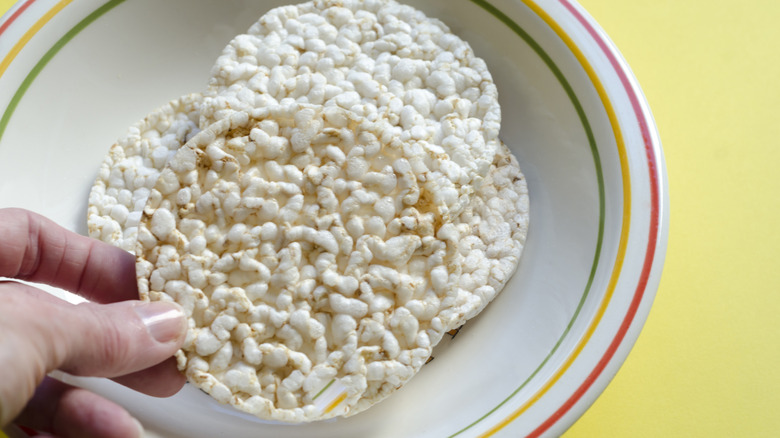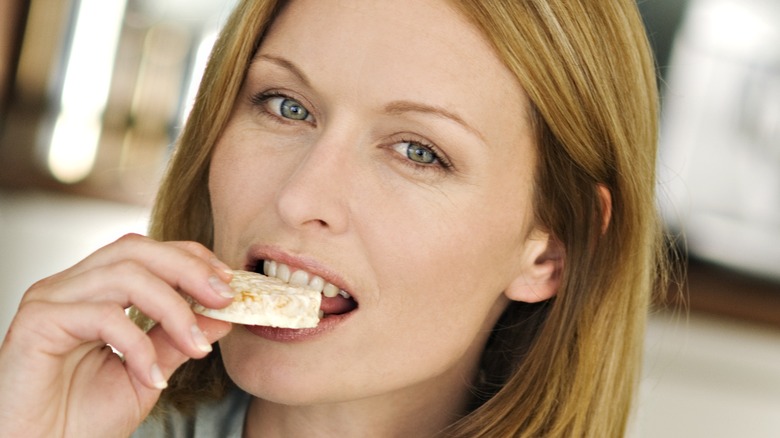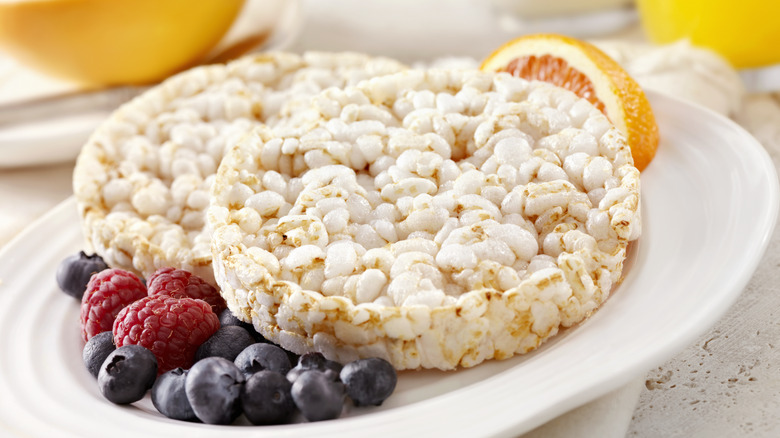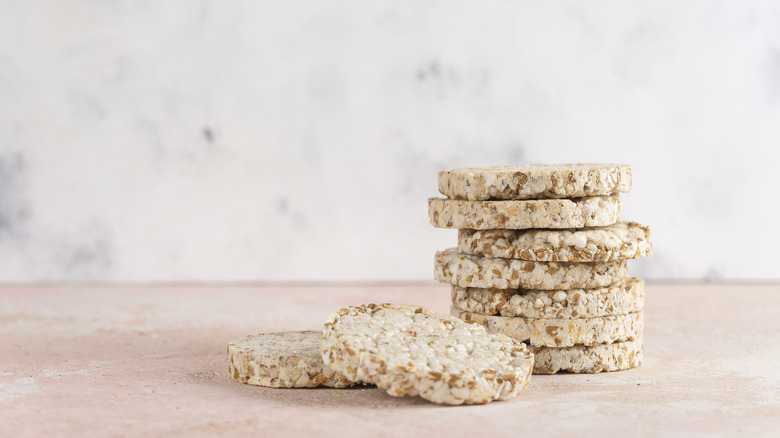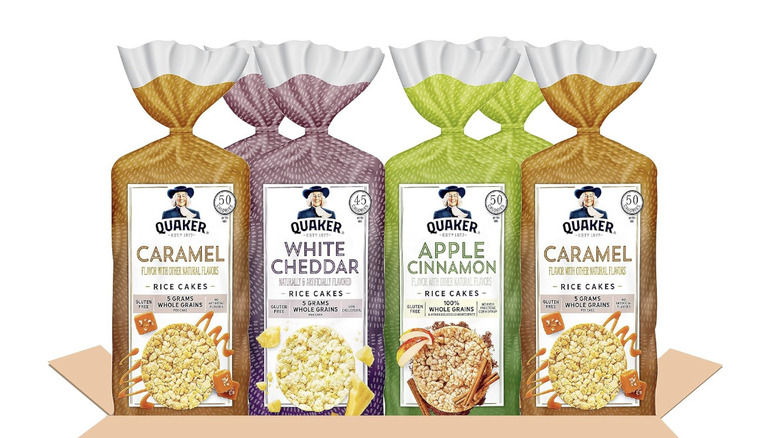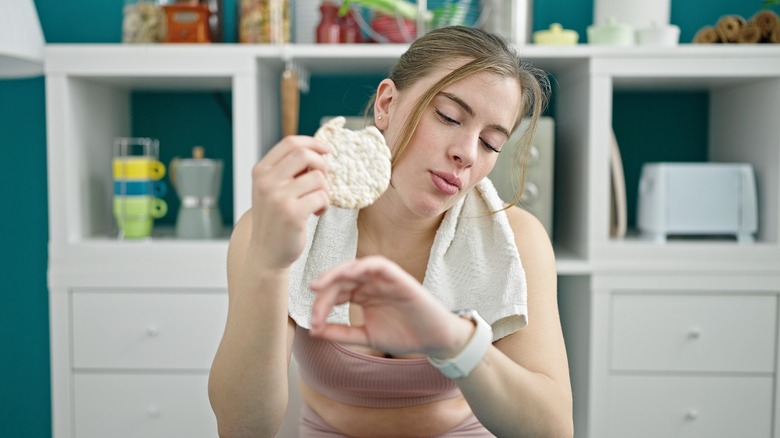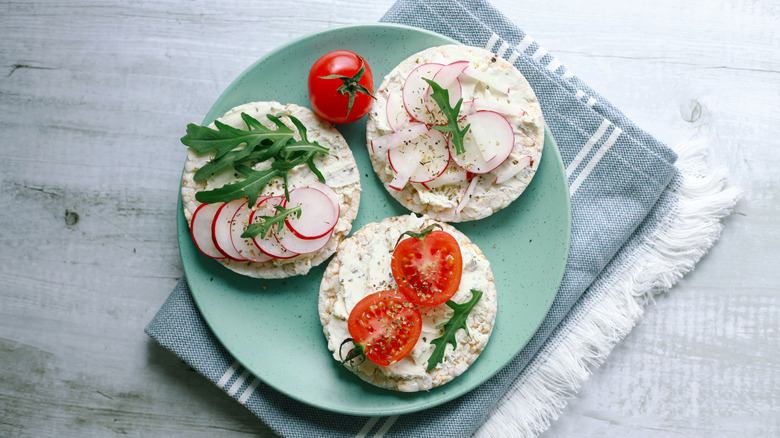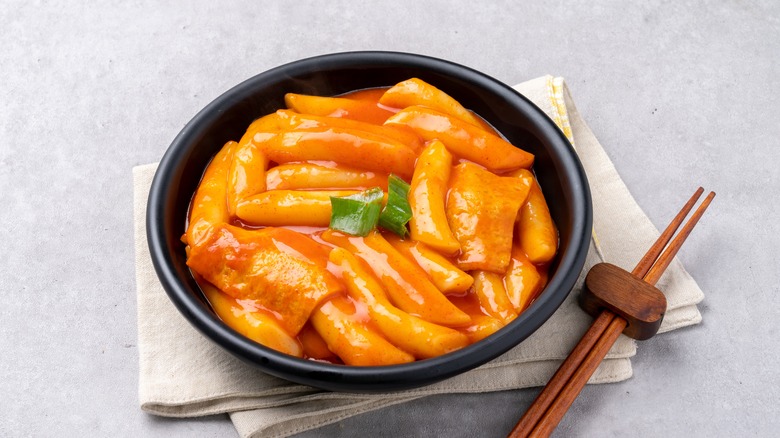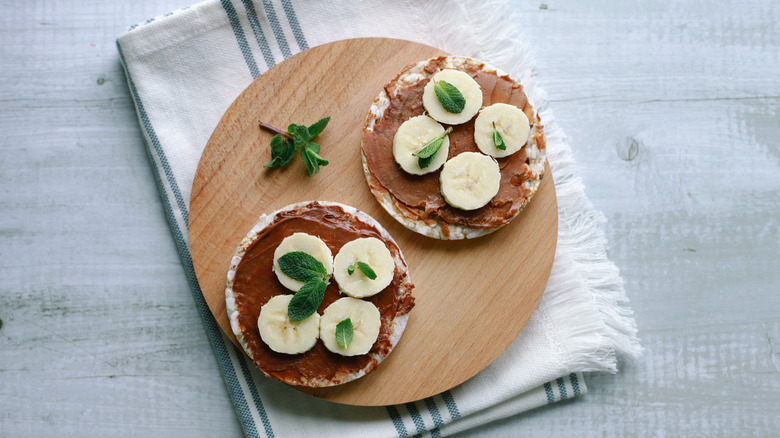Myths About Rice Cakes You Should Stop Believing
We may receive a commission on purchases made from links.
Although there are numerous types of rice-based cakes around the world, in the U.S., we mostly think of rice cakes as circular discs made from puffed rice. Interestingly, this unassuming snack wasn't invented by a chef, but by a botanist named Alexander Pierce Anderson. He discovered steamed puffed rice in 1901 and showcased its production using a special rice "cannon" at the St. Louis World's Fair three years later. Anderson's exhibit was a success. He also sold his interest in the invention to an investment company, which later sold it to Quaker, a company that continues to sell rice cakes to this day.
Rice cakes became popular in the 1980s when they were marketed as a low-calorie snack alternative to chips and other so-called junk food. As a result, they became popular with people on diets, who would often pair them with low-fat toppings. Over time, their variety also expanded, with new flavors and a wider range of ingredients. Keen to find out more about rice cakes? Read on as we debunk some of the biggest myths about this ubiquitous snack.
Rice cakes are always healthy
Most of us view rice cakes as a healthy snack that makes a great low-calorie substitute for crackers and bread. In fact, even though they are marketed as a light snack, rice cakes are comparable in their calorie and carbohydrate content to their culinary competitors. A 9-gram brown rice cake without any flavoring contains 35 calories and 7 grams of carbohydrates. A 9-gram slice of white bread (thin and without crust) has 24 calories and 4.4 grams of carbs. Meanwhile, a 4-gram cracker comes with 20 calories and 2.5 grams of carbs.
Despite their relatively low calorie content, plain rice cakes aren't healthy on their own. This is mainly because they leave a lot to be desired in the nutrition department. Rice cakes lack essential vitamins, minerals, fiber, and protein. In addition, the puffing process is thought to diminish the product's antioxidants. More specifically, one 9-gram rice cake will only provide you with 3% of your daily value of magnesium and phosphorus, 4% of selenium and copper, and 2% of zinc.
Rice cakes are good for weight loss
When viewed in a certain light, plain rice cakes can have an impressive diet-friendly profile for those wishing to lose weight. An average brown rice cake comes with 35 calories, 7 grams of carbohydrates, and 0 fat. However, while this may sound good on paper, if you pay closer attention to labels, you'll notice how devoid of nutritional value most rice cakes are. It's this lack of essential nutrients that can lead to a lack of fullness and overeating.
While rice cakes may appear harmless, they are mostly made up of refined carbohydrates. The high carbohydrate content of rice cakes means that they also have a high glycemic index and are rapidly turned into sugar once digested, as all carbohydrates do, so in order to be most effective as fuel for your body, they should be paired with other types of foods, like proteins and fats. If you want to enjoy a rice cake or two, pair them with nutrient-dense toppings such as some sliced avocado, turkey slices, or hummus.
All rice cakes are gluten free
Gluten is a group of proteins found in some types of grains, including rye, wheat, and barley. This substance is commonly added to bread and other baked goods to give them a chewy texture. Unfortunately, gluten can be difficult to digest for individuals with gluten sensitivity or celiac disease. This is why many of them frequently turn to rice cakes as a substitute for bread.
While most rice cakes are gluten free, this isn't always the case, so it's important to always read the labels carefully prior to making a purchase. Since white, brown, and wild rice are all gluten free, rice cakes made solely from rice will also be free of gluten. The problem is that not all rice cakes contain solely rice. Some puffed rice cakes also incorporate other ingredients, such as barley, flavorings, and can even be affected by cross-contamination during production.
Rice cakes are only available in a plain version
The classic version of puffed rice cakes is unflavored and neutral in taste. This is precisely what makes the snack such a popular low-calorie base for other ingredients. However, modern rice cakes are no one trick pony, coming in a wide array of flavors and textures to suit different tastes. Aside from the lightly salted variety, rice cakes can be found in a range of savory and sweet flavors, offering something for everyone.
Those who enjoy savory options can choose rice cakes flavored with ingredients such as white cheddar or tomato and basil. Meanwhile, fans of sweet flavors can indulge in rice puffs flavored with ingredients like chocolate, apple and cinnamon, or caramel corn. Additionally, rice cakes can incorporate ingredients such as quinoa, flax seeds, millet, and sunflower seeds, all components that change not just the snack's taste and texture, but also nutritional profile. Finally, rice cakes come in various sizes, including bite-sized mini versions for easy snacking on the go.
They are good for diabetics
While rice cakes are sometimes touted as a healthy snack, they aren't for everybody. In particular, individuals with diabetes should approach the rice crisps with caution. This is because rice cakes have a high glycemic index, which means that they can trigger a quick rise in blood sugar levels. Given that people with diabetes need to keep a watchful eye on their blood sugar, rice cakes are less than an ideal option compared to other snacks.
As a rule of thumb, food that's starchy, sugary, and refined has a higher glycemic index than food that is fibrous. So, what is the glycemic index of rice cakes? On a scale from 0 to 100, with 100 being the rating for pure sugar, rice cakes score a high 82. Some other common foods that rank high in the glycemic index department include cornflakes with 81, watermelon with 76, and instant mashed potatoes with 87. Conversely, foods with a low glycemic index include chickpeas with 28, oranges with 43, and chocolate with 40.
Rice cakes have to be bland and boring
Aside from the flavored variety, rice cakes are essentially composed of puffed rice and air. Light, crispy, and flavorless, eating the puffed snack has sometimes even been compared to biting into styrofoam. This, however, can be easily remedied by adding a little creativity into your toppings.
Instead of viewing rice cakes as bland and boring, why not treat them as a culinary blank canvas that can be embellished to suit your taste and mood? After all, the topping possibilities for rice cakes are limited only by your imagination. Pair the puffed rice discs with cottage cheese and avocado or top them with hummus and cucumber for a healthy and nutritious snack. Alternatively, drizzle them with yogurt and berries to make a decadent dessert.
Instead of making egg salad sandwiches, why not make egg salad rice cakes? Simply spread a little egg salad on the crispy rice thins for a lighter alternative to bread. Aside from the rice cakes, all you'll need to make this recipe is eggs, mayonnaise, onions, celery, and Dijon mustard. For an altogether different take on the crispy rice rounds, make rice cake ice cream sandwiches. Depending on your preference, you can either top the rice puffs with ice cream or place it between two rice cakes.
There's only one type of rice cake
When most of us think of rice cakes, we picture the classic white, airy discs, associated with low-calorie snacking. However, this is just one type of the popular snack. The reality is that American-style rice cakes differ from Asian rice cakes and tend to be chewy and dense rather than crispy.
In Japan, mochi rice cakes are usually made from glutinous rice and can come plain or with a variety of savory or sweet fillings, such as red bean paste or strawberries. These chewy snacks are sometimes wrapped in oak leaves, bamboo leaves, or salty pickled cherry leaves, or coated in sweetened ground black sesame or sweetened soybean flour. Meanwhile, Korea is known for its tteok rice cakes, which are made from a mix of flours, such as wheat and rice flour. These steamed rice cakes are typically added to soups, stir-fries, and stews. Similarly, Indonesian lontongs are cylindrical rice cakes compressed in banana leaves and normally used to complement dishes such as stir-fried noodles.
It's hard to make rice cakes at home
Since rice cakes are relatively budget-friendly and perceived as tricky to make, most people opt to buy them ready-made rather than attempt to prepare at home. In fact, making rice cakes in the comfort of your own kitchen shouldn't take longer than around 10 minutes. While they may not taste exactly like the crispy rice rounds you buy at your local supermarket, they can add a unique homemade touch to a meal.
To make rice cakes, you'll need 1 cup of cooked white rice, two eggs, 2 teaspoons of milk, 3 teaspoons of butter, and salt and ground black pepper to taste. The process is very simple. All you have to do is combine the rice, eggs, milk, salt, and pepper in a bowl and form the mixture into patties. Heat the butter in a skillet on medium heat. Let the rice cakes cook until lightly browned, which should take around three minutes, before flipping them on the other side and repeating the process.
